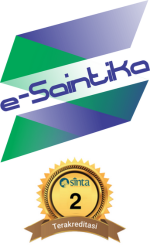Profile of Students' Critical Thinking Skills and the Implementation of PBLRQA based on Blended Learning in Senior High School
Abstract
Keywords
Full Text:
PDFReferences
Alexander, L. (2000). Education & Training On The Internet. An essensial resources for students, teachers and education providers. UK: Internet Handbook.
Asrizal, A., Amran, A., Ananda, A., Festiyed. (2019). Effects of Instructional Material Of Natural Science with Literacy Skills of Our Respiratory And Excretory Health Theme On Academic Achievement Of Student. Journal of Physic: Conference Series, 1317(012174), 1-7.
Bahri, A., Idris, I.S., Muis, H., Arifuddin, M., Fikri, M. J. N. (2021). Blended Learning Integrated with Innovative Learning Strategy to Improve Self-Regulated Learning. International Journal of Instruction, 14(1), 779-794.
Bahri, A., Corebima. A. D. (2019). Improving PBL in Empowering Meta cognitive Skills of Student. Indian Journal of Science and Technology, 12(17), 1-9.
Bakri, F., Permana, H., Vani, N. D., Mulyati, D. (2021). The implementation of problem based learning in elasticities concept. AIP Conference Proceedings, 2320,020001, 1-6.
Deore, K. V. T. (2012). The Educational Advantages of Using Internet. International Educational E-Journal, 1(2), 111-112.
Ennis, R. H. (2011). The Nature of Critical Thingking Assesment. Retreived March 26, 2021 from http://www3.qcc.cuny.edu/WikiFiles/file/Ennis%20Critical%Thinking%20Assesment.pdf
Facione, A.P. (2011). Holistic Critical Thinking Scoring Rubric. California Academia Press: San Fransisco.
Facione. (2013). Critical Thinking: What It Is and Why It Counts. Millbrae, CA: Measured Reasons and The California Academic Press.
Forsyth, I. (2001). Teaching and Learning Materials and The Internet. 3rd Edition. USA.
Garisson, R., & Vaughan, H. (2008). Blended Learning in higher education; Framework, principles and guidelines. San Francisco: Jossey-Bass.
Hasmunarti., Bahri, A., Idris, I. S. (2018). Analisis Kebutuhan Pengembangan Blended Learning Terintegrasi Strategi PBLRQA (Problem Based Learning and Reading, Questionary & Answering) pada Pembelajaran Biologi. Jurnal Biology Teaching and Learning, 1(2), 101-108.
Korkmaz, O., & Karakusm, U. (2009). The impact of bended learning models o student attitudes towards Gepgraphy course and their Critical Thinking dispositions and levels. The Turkish Online Journal of Educational Technology, 8(4), 51-63.
Listiana, L., Raharjo., Hamdani. A. S. (2020). Enhancing Self-Regulation Skills through Group Investigation Integrated with Think Talk Write. International Journal of Instruction, 13(1), 915-930.
Marnita., M. Taufiq., Iskandar., Rahmi. (2020). The Effect of Blended Learning Problem-Based Instruction Model on Student’s Critical Thinking Ability in Thermodynamic Course. Jurnal Pendidikan IPA Indonesia, 9(3), 430-438.
Mundilarto., & Ismoyo, H. (2017). Effect Of Problem-Based Learning on Improvement Physics Achievement And Critical Thinking of Senior High School Student. Journal of Baltic Science Education, 16(5), 761-780.
Patnership for 21st Century Skills (P21). (2009). Retreived March 26, 2021 from http://www.p21.org/our-work/p21-framework
Prameswari, S.W., Suharno., Sarwanto. (2018). Inculcate Critical Thinking Skills in Primary Schools. SHEs: Coference Series, 1(1), 742-750.
Rahmawati, D.U., Jumadi., Ramadan, E. M. (2020). Developing Physics Learning Tools of Blended Learning Using Schoology with Problem-Based Learning Model. JPPPF (Jurnal Penelitian dan Pengembangan Pendidikan Fisika), 6(2), 139-152.
Ricketts, J.C. (2004). Critical thinking skills of FFA leaders. Journal of Southern Agricultural Eduaction Research, 54(1), 7-20.
Rosenthal, D. dan Weit, R. (2012). Large-Course Redesign via Blended Learning: A Post-Implementation Assesment Across Institutions. International Journal on E-Learning, 11(2), 189-207.
Sarwi, A., Rusilowati, A., Khanafiyah S. (2012). Implementasi Model Eksperimen Gelombang Open-Inquiry Untuk Mengembangkan Kemampuan Berpikir Kritis Mahasiswa Fisika. Jurnal Pendidikan Fisika Indonesia, 8(1), 41-50.
Sharma, P. (2010). Blended Learning. ELT Journal, 64(4), 456-458.
Sucirahayu, S., Halim, A., Idris, N. (2015). Penerapan Model Problem Based Learning (PBL) pada Konsep Usaha dan Energi Untuk Meningkatkan Keterampilan Berpikir Kritis dan Berpikir kreatif Siswa SMA. Indonesian Jurnal of Science, 3(1), 207-217.
Sugiyono. (2010). Metode Penelitian Pendidikan Pendekatan Kuantitatif, kualitatif, dan R&D. Bandung: Alfabeta.
Sulaiman, F. (2013). The Effectiveness of PBL Online on Physics Student’s Creativity and Critical Thinking: A Case Study at University Malasyia Sabah. International Journal of Education and Research, 1(3), 1-18.
Sungur, S., & Tekayya, C. (2006). Effects of problem-based learning and traditional instruction on self-regulated learning. The Journal of Educational Research, 99(5), 307-320.
Susilawati., Ristanto, S., Khoiri, N. (2015). Pembelajaran Real Laboratory dan Tugas Mandiri Fisika pada Siswa SMK sesuai dengan Keterampilan Abad 21. Jurnal Pendidikan Fisika Indonesia, 11(1), 73-83.
Synder, L. G., dan Synder, M. J. (2008). Teaching Critical Thinking and Problem Solving Skills. The Delta Pi Epsilon Journal, 1(2), 90-99.
Witelson, S. F., Glezzer, I.I., Kigar, D.L. (1995). Women Have Greater Density of Neurons in Posterior Temporal Cortex. The Journal of Neuroscience, 15(5), 3418-3428.
Yulianti, D. (2016). Problem-Based Learning Model Used to Scientific Approach Based Worksheet for Physics to Develop Senior High School Students Characters. Journal of Physic: Conference Series, 824(012009), 1-6.
Yuliati, L., Fauziah, R., Hidayat, A. (2018). Student’s Critical Thinking Skills in Authentic Problem Based Learning. Journal of Physic: Conference Series, 1013(012025), 1-7.
DOI: https://doi.org/10.33394/j-ps.v9i1.3911
Refbacks
- There are currently no refbacks.
Copyright (c) 2021 Febtya Lailatul Badriyah, Husni Mubarok, Binar Kurnia Prahani

This work is licensed under a Creative Commons Attribution 4.0 International License.

J-PS (Prisma Sains: Jurnal Pengkajian Ilmu dan Pembelajaran Matematika dan IPA IKIP Mataram) p-ISSN (print) 2338-4530, e-ISSN (online) 2540-7899 is licensed under a Creative Commons Attribution 4.0 International License.












 https://orcid.org/0000-0003-4395-5221
https://orcid.org/0000-0003-4395-5221